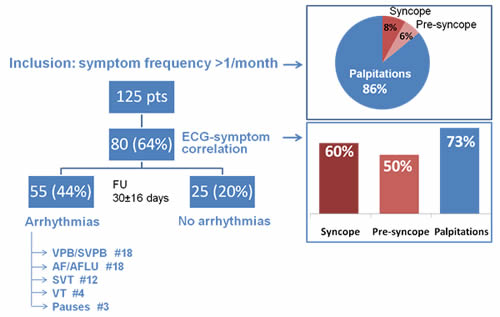I - Types of ELRs
All modern ELRs have features which allow transmission of stored ECG tracing directly to the hospital or via an intermediate Service Centre. The transmission ranges from the simple, delayed on call, analogic dial-in trans-telephonic system to the more sophisticated automatic via Bluetooth wireless link or to personal data manager (PDA) and then trans-telephonic to the service center. No system is proven to be superior to the other.
II - Diagnosis of undocumented syncope and pre-syncope
The major limitation of ELRs for diagnosis of unpredictable and infrequent symptoms such as syncope is that the patients must wear external electrodes continuously in order to activate loop memory. The ELR appears to have its greatest role in motivated patients with frequent (pre)-syncopes where spontaneous symptoms are likely to recur within 4-6 weeks. This time frame is usually the longest period during which a patient can be expected to comply; shorter durations lead to lower diagnostic yield. Indications depend on the knowledge of the probability of recurrence.
Since true syncope usually recurs unpredictably over months or years, the indications for ELR are limited to few selected patients with a high probability of recurrence. The diagnostic yield in such patients is even quite low. In one study (1), among 24 patients with a mean of 3 episodes during the previous 6 months and no structural heart disease, only 1 syncopal episode could be recorded by ELR which showed sinus tachycardia. In another study (2), among 57 patients with a median of 10 syncopes during the last year, a diagnosis was made in 25%, a significant arrhythmia being diagnosed in 5 (9%).
ELRs proved to be more useful when frequent pre-syncopal symptoms were considered in addition to true syncopal episodes and less specific positivity criteria are used, mainly in order to exclude an arrhythmic cause of symptoms. For example, in the COLAPS trial (3), an ECG-symptom correlation was found in 44/78 patients (56%), but an arrhythmia was identified in only 1 patient, whereas it could be excluded in the other 43. In a multicenter study (4), a symptom-arrhythmia correlation was found in 15% and symptom-absence of arrhythmia correlation was found in another 25% of 51 patients; these rates were 27% and 14% respectively when an auto-trigger device was used in another 62 patients.
With the new auto-triggered devices, many asymptomatic tachy-arrhythmias are usually recorded (4). It should be stressed that, in the absence of a correlation study with syncopal events, their positive predictive value is unknown, and monitoring should be continued until diagnosis is confirmed by symptom documentation whenever possible.
III - Diagnosis of undocumented palpitations
In clinical studies in which patients with at least a weekly recurrence of palpitations were included, external loop recorders as well as event recorders showed a consistent diagnostic yield of 63-75%, superior to that of conventional Holter monitoring (5,6,7,8,9,10)
In the Syncope Unit at Lavagna hospital, from January 2005 to July 2007, ELPs were applied to 125 patients (56±19 years, 60% females) for an average of 30±15 days. The inclusion criteria were recurrent undocumented symptoms with a recurrence rate >1 per month. The patients with undocumented palpitations were more likely to have frequent recurrent symptoms than those with pre-syncope or syncope, therefore palpitations was the most frequent reason for ELR application (Figure). An ECG-symptom correlation was obtained in 64% of patients and was similar in those with palpitations, pre-syncope and syncope. When an arrhythmia was the cause of the symptoms, this was more frequently an atrial tachyarrhythmia (atrial fibrillation, flutter or tachycardia). Repetitive premature beats were also frequently encountered whereas wide QRS tachycardia or pauses were much less frequent.
Figure. ELRs experience at the Syncope Unit of the Lavagna hospital.

Conclusion:
• ELRs are indicated in patients with recurrent palpitations, pre-syncope or syncope who have inter-symptom interval ? 4 weeks, and absence of high risk criteria which require immediate hospitalisation or intensive evaluation.
• ELR findings are diagnostic for therapeutical decision when a correlation between palpitation and an arrhythmia is detected. ELR findings exclude an arrhythmic cause when there is no correlation between palpitation and rhythm variation. The meaning of asymptomatic arrhythmias remains uncertain and monitoring should be continued until the index symptom is documented.
• ELRs are much more useful for palpitations than for syncope evaluation
• The diagnostic value of loop recorders is higher than that of Holter
The content of this article reflects the personal opinion of the author/s and is not necessarily the official position of the European Society of Cardiology.


 Our mission: To reduce the burden of cardiovascular disease.
Our mission: To reduce the burden of cardiovascular disease.